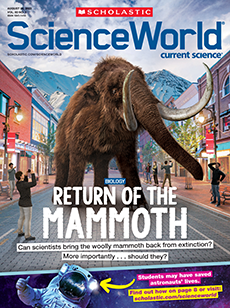BEN BOOTH/UNIVERSITY OF BRISTOL
SPOT THE DIFFERENCE: A selection of elephant and mammoth ivory samples
It’s against international law to sell ivory from the tusks of elephants—but not from the tusks of ancient mammoths. Unfortunately, it’s difficult to determine where a piece of ivory came from, or even how old it is. “It’s often hard to tell, especially from a carved object, whether it was made from legal mammoth ivory or illegal elephant ivory,” says Adrian Lister. He’s a paleobiologist—a scientist who studies the biology of ancient life—at the Natural History Museum in England.
That’s why scientists in England developed a cutting-edge method that uses lasers to distinguish between ancient mammoth ivory and newer ivory from elephants. The concentrated beams of light cause bonds between atoms—the smallest units of matter—in the sample to vibrate. These vibrations allow scientists to identify the composition of the ivory and determine what animal it is from. This could become a valuable tool to reduce the sales of illegally poached ivory.
